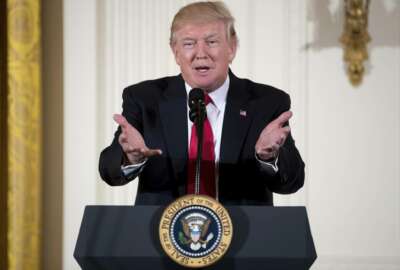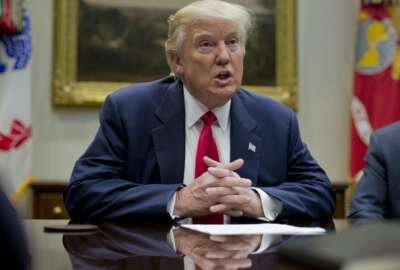
EPA personnel cuts aren’t only cost-saving ideas Trump has in mind for 2018 budget
A 31 percent cut to the Environmental Protection Agency's budget in fiscal 2018 would force EPA to cut nearly 4,000 full time equivalent employees, begin...
A 31 percent cut to the Environmental Protection Agency’s budget would force it to eliminate at least 50 individual programs and nearly 4,000 full-time equivalents in fiscal 2018, according to internal EPA documents that describe funding levels and policy decisions that support the President Donald Trump’s 2018 budget request.
The documents, which Federal News Radio obtained, also describe areas where the administration hopes to consolidate agency programs and offices to bring EPA spending to roughly $5.7 billion.
But other efforts would change the way EPA approaches acquisition, cybersecurity and IT modernization and its real property footprint — and may indicate what’s in store for other agencies as they prepare for a reorganize, reshape their workforce and focus in on evidence-based priorities.
“The resource levels require us to think about the work we do and how we do it, the way we are organized and the geographic location and spaces we occupy,” David Bloom, EPA’s acting chief financial officer said in a March 21 message to agency officials on the proposed budget. “The agency will continue to seek opportunities to reduce further our facility footprint and/or implement planned and pending moves in an expedited and cost effective manner.”
According to the President’s 2018 request, spending levels will force the agency to assume a full-time equivalent (FTE) ceiling of about 11,547, the budget document said. EPA had about 15,375 FTEs in fiscal 2016, according to the agency’s 2017 budget review.
“The hiring freeze will remain in place while the agency develops a comprehensive workforce reshaping plan,” the 2018 spending plan said. “The agency will chart a workforce path that seeks to align capacity with administration priorities, takes advantage of opportunities for more efficient practices and organizational structures, minimizes separation costs and enables adjustment to final appropriation levels without major disruptions to the agency’s work.”
Human resources staff would generally be spared from any agency reductions in force or layoffs, because EPA will need a “fully operational human resources program to perform workforce reshaping activities,” the documents said.
This comes as OPM recently gave agency heads and human resources staff new guidance on workforce reshaping, as well as an updated overview on issuing administrative furloughs.
Cutting or consolidating programs and staff isn’t the only cost-saving move that the administration has in mind for EPA.
It’s also tasking EPA’s Office of Environmental Information to retire or replace one high priority legacy IT system with either a cloud solution or shared services starting in fiscal 2018. EPA must send a modernization plan to OMB by Apr. 3.
“The total estimated project cost must fit within topline guidance levels and shall not assume an increase in out-year IT resources,” Bloom said in the document. “The planned transition should not exceed two years, and shall not be a modernization that is already in progress as of Jan. 31, 2017. The project must modernize a system that is currently designated as ‘major’ on the IT Dashboard, comply with relevant cybersecurity standards, demonstrate improvements in operational effectiveness and incorporate sound estimates of annual cost avoidance.”
Yet Ann Dunkin, a former EPA chief information officer who served at the agency for nearly two years during the Obama administration, said finding a program that didn’t have some modernization efforts already underway, and then transforming it under the administration’s timeline, would be a serious challenge.
“There is no team in EPA that could transform a [Capital Planning and Investment Control] CPIC major from legacy to modern design within two years,” she wrote in an email to Federal News Radio. “We were just beginning to put the tools in process to enable organizations to effectively implement agile and modern development practices. That capability is pretty embryonic, and trying to take on a big program in a stressed, constrained environment would likely result in failure.”
Budget documents detail some staffing cuts at the EPA OEI, which Dunkin said was already under-resourced during her tenure at the agency. Though the budget justification mentions the office would refocus and shift some of its current priorities to work on modernization and cybersecurity initiatives, Dunkin said organizational challenges would complicate the project.
“Because much of OEI’s work is outsourced, a reduction in agency headcount doesn’t result in reduced headcount in OEI, so OEI doesn’t have the headcount to do the modernization,” she wrote. “They only have a handful of staff capable of working on it, and the systems that require modernization reside in other organizations that will not easily give them up to OEI.”
In addition, the administration will encourage EPA, along with other agencies, “to aggressively pursue strategic sourcing opportunities,” the budget document said.
The Trump administration will look to the EPA Office of Administration and Resources Management (OARM) for suggestions in aligning contracting activities at the agency’s regional offices with procurement initiatives at EPA headquarters and governmentwide.
Latest Budget News
EPA is also working with OMB and the General Services Administration to look at its offices, warehouses and laboratory space in effort to consolidate its physical footprint, the spending plan said.
“The agency is seeking opportunities to further reduce our facility footprint and/or implement planned and pending moves/consolidation in an expedited and most cost effective manner,” the document said.
Consolidation projects are already underway in Corvallis, Oregon, and Lakewood, Colorado, and should be finished in 2018. EPA is also on track to complete much of its work consolidating labs in Athens, Georgia, next year as well.
The President’s 2018 budget assumes the agency would avoid rent costs from several regional and headquarters offices across the country, release the Washington, D.C. headquarters warehouse and decommission part of a Las Vegas, Nevada, laboratory.
These documents offer a glimpse into the administration’s thinking for fiscal 2018 but by no means represent the agency’s final spending figures. A full budget request from President Trump is expected sometime in May. Agencies, including EPA, should have an opportunity to discuss their priorities with congressional appropriations committees.
But the Trump administration has long hinted of significant EPA budget cuts. And the spending levels detailed in the March 21 documents indicate that reductions may be deeper than what the administration announced. Initial budget breakdowns for the EPA described cuts to roughly two dozen programs and a 20 percent cut to the agency’s staff.
Copyright © 2025 Federal News Network. All rights reserved. This website is not intended for users located within the European Economic Area.
Nicole Ogrysko is a reporter for Federal News Network focusing on the federal workforce and federal pay and benefits.
Follow @nogryskoWFED
Related Stories

EPA leaders, advocates urge Trump administration to reconsider cuts to budget and workforce

FY18 budget cuts could slice into civilian agency programs, personnel




